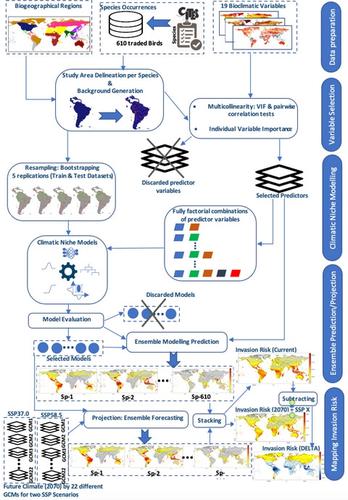当前位置:
X-MOL 学术
›
Glob. Change Biol.
›
论文详情
Our official English website, www.x-mol.net, welcomes your feedback! (Note: you will need to create a separate account there.)
Potential for invasion of traded birds under climate and land-cover change
Global Change Biology ( IF 11.6 ) Pub Date : 2022-07-18 , DOI: 10.1111/gcb.16310 Babak Naimi 1 , César Capinha 2 , Joana Ribeiro 3, 4, 5 , Carsten Rahbek 6, 7, 8, 9 , Diederik Strubbe 10 , Luís Reino 3, 4, 5 , Miguel B Araújo 1, 11
Global Change Biology ( IF 11.6 ) Pub Date : 2022-07-18 , DOI: 10.1111/gcb.16310 Babak Naimi 1 , César Capinha 2 , Joana Ribeiro 3, 4, 5 , Carsten Rahbek 6, 7, 8, 9 , Diederik Strubbe 10 , Luís Reino 3, 4, 5 , Miguel B Araújo 1, 11
Affiliation

|
Humans have moved species away from their native ranges since the Neolithic, but globalization accelerated the rate at which species are being moved. We fitted more than half million distribution models for 610 traded bird species on the CITES list to examine the separate and joint effects of global climate and land-cover change on their potential end-of-century distributions. We found that climate-induced suitability for modelled invasive species increases with latitude, because traded birds are mainly of tropical origin and much of the temperate region is ‘tropicalizing.’ Conversely, the tropics are becoming more arid, thus limiting the potential from cross-continental invasion by tropical species. This trend is compounded by forest loss around the tropics since most traded birds are forest dwellers. In contrast, net gains in forest area across the temperate region could compound climate change effects and increase the potential for colonization of low-latitude birds. Climate change has always led to regional redistributions of species, but the combination of human transportation, climate, and land-cover changes will likely accelerate the redistribution of species globally, increasing chances of alien species successfully invading non-native lands. Such process of biodiversity homogenization can lead to emergence of non-analogue communities with unknown environmental and socioeconomic consequences.
中文翻译:

气候和土地覆盖变化下交易鸟类入侵的可能性
自新石器时代以来,人类已经将物种迁离其原生地,但全球化加速了物种迁徙的速度。我们为 CITES 清单上的 610 种交易鸟类拟合了超过 50 万个分布模型,以检查全球气候和土地覆盖变化对其潜在的世纪末分布的单独和联合影响。我们发现,模拟入侵物种的气候诱导适应性随着纬度的增加而增加,因为交易的鸟类主要来自热带,而大部分温带地区正在“热带化”。相反,热带地区正变得更加干旱,从而限制了热带物种跨大陆入侵的可能性。由于大多数交易的鸟类都是森林居民,因此热带地区的森林损失加剧了这一趋势。相比之下,整个温带地区森林面积的净增长可能会加剧气候变化的影响,并增加低纬度鸟类定居的可能性。气候变化总是导致物种的区域重新分布,但人类交通、气候和土地覆盖变化的结合可能会加速全球物种的重新分布,增加外来物种成功入侵非本土土地的机会。这种生物多样性同质化过程可能导致出现具有未知环境和社会经济后果的非模拟社区。土地覆盖的变化可能会加速全球物种的重新分布,增加外来物种成功入侵非本土土地的机会。这种生物多样性同质化过程可能导致出现具有未知环境和社会经济后果的非模拟社区。土地覆盖的变化可能会加速全球物种的重新分布,增加外来物种成功入侵非本土土地的机会。这种生物多样性同质化过程可能导致出现具有未知环境和社会经济后果的非模拟社区。
更新日期:2022-07-18
中文翻译:

气候和土地覆盖变化下交易鸟类入侵的可能性
自新石器时代以来,人类已经将物种迁离其原生地,但全球化加速了物种迁徙的速度。我们为 CITES 清单上的 610 种交易鸟类拟合了超过 50 万个分布模型,以检查全球气候和土地覆盖变化对其潜在的世纪末分布的单独和联合影响。我们发现,模拟入侵物种的气候诱导适应性随着纬度的增加而增加,因为交易的鸟类主要来自热带,而大部分温带地区正在“热带化”。相反,热带地区正变得更加干旱,从而限制了热带物种跨大陆入侵的可能性。由于大多数交易的鸟类都是森林居民,因此热带地区的森林损失加剧了这一趋势。相比之下,整个温带地区森林面积的净增长可能会加剧气候变化的影响,并增加低纬度鸟类定居的可能性。气候变化总是导致物种的区域重新分布,但人类交通、气候和土地覆盖变化的结合可能会加速全球物种的重新分布,增加外来物种成功入侵非本土土地的机会。这种生物多样性同质化过程可能导致出现具有未知环境和社会经济后果的非模拟社区。土地覆盖的变化可能会加速全球物种的重新分布,增加外来物种成功入侵非本土土地的机会。这种生物多样性同质化过程可能导致出现具有未知环境和社会经济后果的非模拟社区。土地覆盖的变化可能会加速全球物种的重新分布,增加外来物种成功入侵非本土土地的机会。这种生物多样性同质化过程可能导致出现具有未知环境和社会经济后果的非模拟社区。



























 京公网安备 11010802027423号
京公网安备 11010802027423号